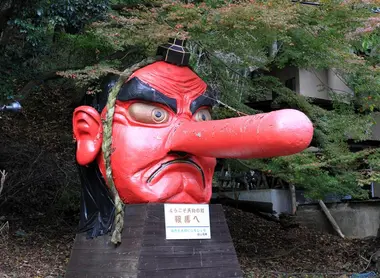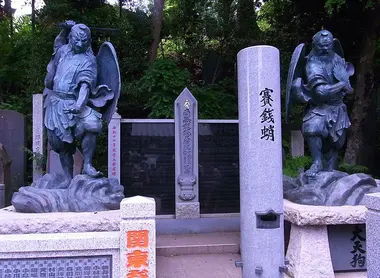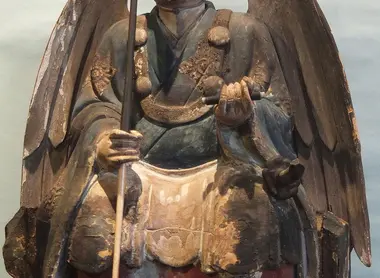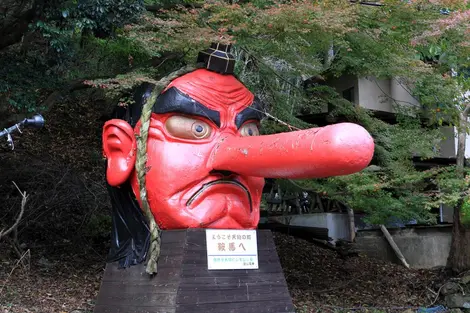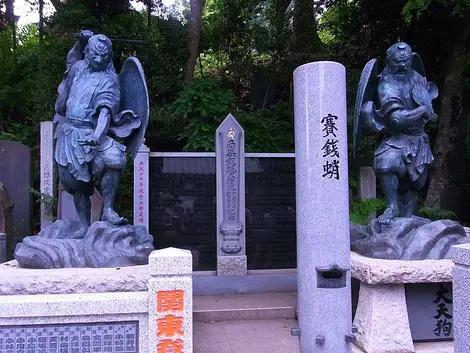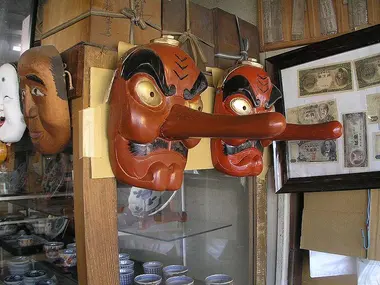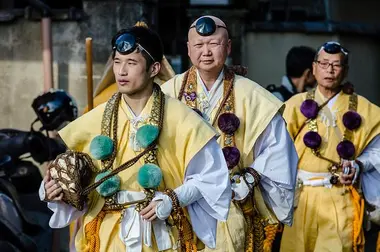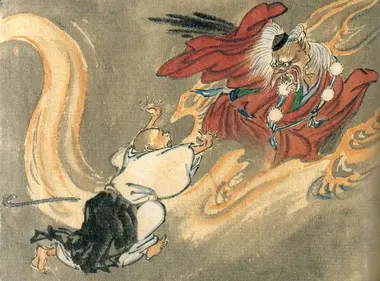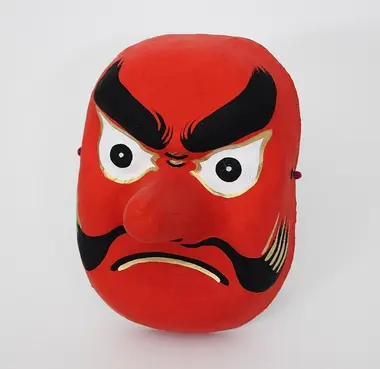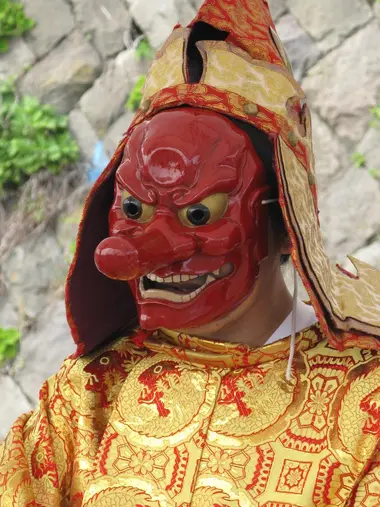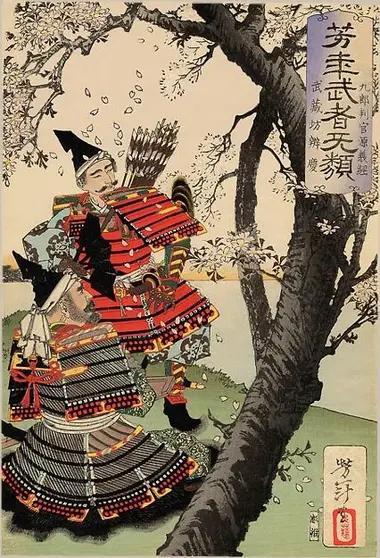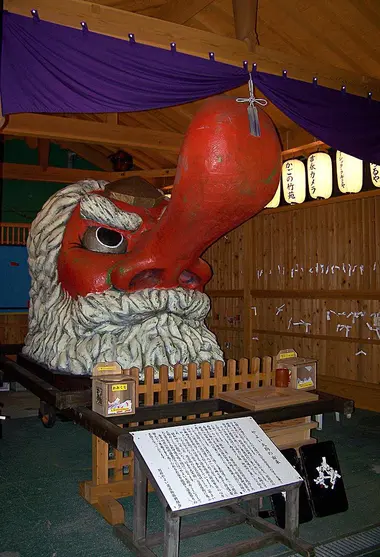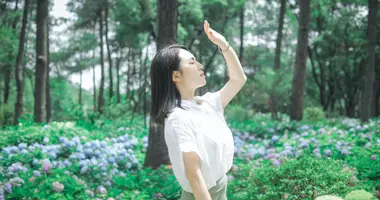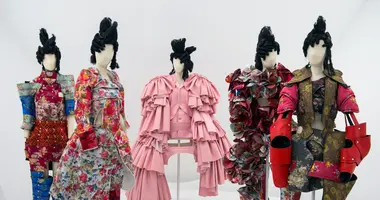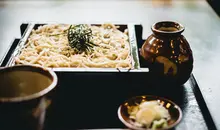Le tengu : le démon au long nez
- Publié le : 10/02/2024
- Par : S.R. / I.D.O.
- Youtube
Le tengu, créature emblématique du folklore japonais, fascine depuis des siècles par son apparence saisissante et son rôle complexe dans la mythologie nippone. Mi-homme mi-oiseau, ce yokai au visage rouge et au long nez incarne à la fois la menace et la protection, oscillant entre démon malveillant et divinité tutélaire. Des montagnes sacrées aux temples bouddhistes, le tengu a marqué l'imaginaire japonais, évoluant au fil du temps pour devenir une figure incontournable de la culture populaire. Plongeons dans l'univers mystérieux de ce démon au long nez, dont l'histoire reflète les transformations de la société japonaise elle-même.
Origines et évolution du tengu dans la mythologie japonaise
Les racines du tengu remontent à l'antiquité japonaise, avec des mentions dans les premiers textes écrits comme le Nihon Shoki (720). Initialement, le tengu était représenté comme une créature aux caractéristiques canines, inspirée du "chien céleste" (天狗, tengu) de la mythologie chinoise. Au fil des siècles, son apparence a évolué pour devenir plus aviaire, reflétant peut-être l'influence de la divinité bouddhique Garuda.
L'évolution du tengu est intimement liée à l'histoire religieuse du Japon. D'abord considéré comme un ennemi du bouddhisme, il était associé aux esprits vengeurs de moines arrogants ou hérétiques. Le bouddhisme et le religion shinto ont influencé sa perception, le transformant progressivement en une figure plus ambivalente, à la fois redoutée et respectée.
Au Moyen Âge, le tengu est devenu un personnage central de nombreuses légendes, comme celle de l'empereur Sanjô rendu aveugle par un tengu vengeur. Ces récits témoignent de l'importance croissante du tengu dans l'imaginaire collectif japonais, reflétant les tensions sociales et religieuses de l'époque.
Apparence et caractéristiques du tengu
L'apparence du tengu a considérablement évolué au fil du temps. Son visage rouge cramoisi, ses yeux perçants et son long nez sont devenus ses traits distinctifs les plus reconnaissables. Ce nez proéminent, selon le Nihon Shoki, mesurerait "sept paumes de long" et serait une anthropomorphisation d'un bec originel.
Le tengu est souvent représenté vêtu comme un yamabushi, ces guerriers ascètes des montagnes. Il porte généralement une robe de prêtre, un chapeau distinctif et tient un éventail de plumes (ha-uchiwa) symbolisant son pouvoir sur le vent. Ses ailes, vestige de son origine aviaire, lui permettent de voler et d'atteindre des lieux inaccessibles aux humains.
La physionomie du tengu reflète sa nature complexe : à la fois terrifiante et majestueuse. Son expression faciale, souvent grimaçante ou colérique, traduit sa réputation d'être fier et vindicatif. D'ailleurs, l'expression japonaise "tengu ni naru" (devenir un tengu) désigne une personne devenue arrogante, soulignant cette caractéristique emblématique du personnage.
Les différents types de tengu
La mythologie japonaise distingue principalement deux types de tengu : les daitengu et les kotengu. Les daitengu, ou "grands tengu", sont les plus puissants et les plus sages. Ils ont une apparence plus humaine, avec le fameux long nez rouge. Parmi les daitengu les plus célèbres, on peut citer Sōjōbō du mont Kurama, réputé pour avoir enseigné les arts martiaux au légendaire samouraï Minamoto no Yoshitsune.
Les kotengu, ou "petits tengu", sont moins puissants et plus proches de leur forme aviaire originelle. Souvent appelés karasu-tengu (tengu corbeaux), ils ont un aspect moins anthropomorphe et plus sauvage. Ces kotengu sont généralement considérés comme les serviteurs ou les subordonnés des daitengu.
Il existe également d'autres variations régionales de tengu, comme les guhin ou les kawatengu, chacun avec ses propres caractéristiques et légendes associées. Cette diversité témoigne de la richesse du folklore tengu à travers le Japon, chaque région ayant développé ses propres traditions et croyances autour de ces créatures fascinantes.
Rôles et pouvoirs attribués aux tengu
Les tengu sont réputés pour leurs nombreux pouvoirs surnaturels. Ils excellent dans le contrôle des éléments, en particulier le vent, qu'ils manipulent grâce à leur éventail magique. Leur capacité de vol et leur vitesse surhumaine en font des adversaires redoutables.
Une des caractéristiques les plus célèbres des tengu est leur maîtrise des arts martiaux. Les arts martiaux japonais sont souvent associés à ces créatures, qui auraient transmis leurs techniques à de grands guerriers comme Minamoto no Yoshitsune. Cette réputation a contribué à faire du tengu une figure respectée dans la tradition martiale japonaise.
Les tengu sont également connus pour leur capacité à se métamorphoser et à créer des illusions. Ils peuvent posséder les humains, les enlever ou les égarer dans les montagnes. Ces pouvoirs reflètent leur nature ambivalente : tantôt malveillants, tantôt protecteurs, ils incarnent les forces mystérieuses de la nature.
Au fil du temps, le rôle des tengu a évolué. D'abord considérés comme des ennemis du bouddhisme, ils sont progressivement devenus des gardiens des montagnes et des forêts. Certains sont même vénérés comme des divinités protectrices, capables d'accorder des faveurs aux humains qui les respectent.
Le tengu dans la culture populaire japonaise
Le tengu occupe une place importante dans la culture populaire japonaise moderne. On le retrouve dans de nombreux mangas, animes et jeux vidéo, où il est souvent représenté comme un personnage puissant et mystérieux. Par exemple, dans le manga "Demon Slayer", le personnage d'Urokodaki Sakonji porte un masque de tengu, illustrant la persistance de cette figure dans l'imaginaire contemporain.
Les festivals traditionnels continuent de célébrer les tengu. Le festival de Shimokita Tengu Matsuri à Tokyo, qui se déroule chaque année en février dans le quartier Shimokitazawa, est un exemple vivant de la façon dont ces créatures mythiques restent ancrées dans la culture populaire. Lors de ce festival, un défilé mettant en scène des tengu parcourt les rues, distribuant des haricots porte-bonheur.
L'image du tengu est également utilisée dans le marketing et le design, apparaissant sur des masques, des objets décoratifs et même des emballages de produits alimentaires. Cette omniprésence témoigne de la fascination continue qu'exerce le tengu sur la société japonaise moderne, transcendant son origine mythologique pour devenir un symbole culturel à part entière.
Où rencontrer des tengu au Japon
Bien que les tengu soient des créatures mythiques, de nombreux lieux au Japon sont associés à leur légende. Le mont Kurama, près de Kyoto, est particulièrement célèbre pour son association avec Sōjōbō, le roi des tengu. Les visiteurs peuvent explorer le temple Kurama-dera et les sentiers de randonnée environnants, imprégnés de l'atmosphère mystique liée aux légendes des tengu.
À Tokyo, le mont Takao est un autre site réputé pour ses connections avec les tengu. Le temple Yakuo-in, situé sur la montagne, abrite des statues de tengu et organise des festivals en leur honneur. C'est un lieu idéal pour découvrir le folklore tengu tout en profitant d'une randonnée pittoresque.
Plusieurs festivals à travers le Japon célèbrent les tengu :
- Le festival de Numata dans la préfecture de Gunma, où de grands masques de tengu sont paradés dans les rues.
- À Osaka, un festival en octobre permet aux femmes d'être "touchées" par un tengu pour s'assurer d'avoir des enfants en bonne santé.
- La ville de Furubira à Hokkaido organise des festivals où les tengu marchent sur le feu.
Pour les voyageurs intéressés par l'exploration de ces lieux mythiques, Pour visiter Gunma en toute liberté, pourquoi ne pas louer une voiture ? Ou encore, Découvrez Nagano grâce à un de nos circuits organisés ! pour visiter le mont Izuna, lieu de résidence du célèbre tengu Izuna Saburō.
Signification et symbolique du tengu dans la culture japonaise
Le tengu incarne une dualité profonde dans la culture japonaise. À la fois démon et divinité, il symbolise les forces mystérieuses de la nature et la complexité de l'expérience spirituelle. Son évolution, d'ennemi du bouddhisme à protecteur des montagnes, reflète les changements dans la perception religieuse et philosophique au Japon.
Dans la tradition martiale, le tengu représente la maîtrise ultime et la sagesse cachée. Son association avec les arts martiaux en fait un symbole d'excellence et de discipline, inspirant les pratiquants à transcender leurs limites humaines.
Le long nez du tengu est devenu un symbole de l'arrogance et de la vanité dans la culture japonaise. L'expression "tengu ni naru" (devenir un tengu) met en garde contre les dangers de l'orgueil excessif, rappelant l'importance de l'humilité dans la société japonaise.
Aujourd'hui, le tengu continue de fasciner et d'inspirer, servant de pont entre le passé mythologique et le présent. Il incarne la capacité du Japon à préserver ses traditions tout en les réinventant pour les générations futures. Le tengu reste ainsi un symbole puissant de l'identité culturelle japonaise, rappelant l'importance de l'équilibre entre le respect des traditions et l'ouverture au changement.
Pour ceux qui souhaitent approfondir leur découverte de la culture japonaise traditionnelle, Et pour découvrir un Japon authentique et bucolique, aux portes de Kyoto, offre une expérience unique au cœur des paysages qui ont nourri ces légendes fascinantes. Pour découvrir un Japon mystique, découvrez notre circuit en voiture : L'âme Shinto Dans Les Embruns, vous permettra de plonger dans l'atmosphère spirituelle qui a donné naissance aux légendes des tengu et autres créatures mythiques du Japon.
